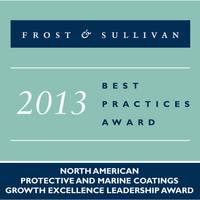Hempel Launches Hempasil X3+ Fouling Release Coating
Building on its Hempasil range of fouling release systems, marine coatings manufacturer Hempel has launched a new antifouling, Hempasil X3+, a biocide free, two-component, fouling release coating with a high solids content. Targetting improved fuel savings, Hempasil X3+ creates a smooth, low energy surface with fouling release properties via itd hydrogel micro layer that prevents fouling organisms from firmly adhering to the hull while retaining the self-cleaning properties of silicone. The product is a completely biocide free paint and has no impact on the marine environment which assists shipowners fulfil their obligations to the environment, Hempel said.
Hempel Receives Award for Revenue Growth

Based on its recent analysis of the North American protective and marine coatings market, Frost & Sullivan recognized Hempel with the 2013 Growth Excellence Leadership Award. In 2012, Hempel exhibited double-digit revenue growth well in excess of 20% and increased its overall market share in North America to 9.5%. Frost & Sullivan noted that Hempel’s competitors’ revenue growth rates are more closely aligned with the base year total market growth rate of 2.1%. Hempel’s acquisition of Blome International in 2012 complemented its existing product lines, especially for the oil and gas industry.
Vale Vessels to Use Hempel Coatings
Hempel recently signed a contract with Brazilian mining giant Vale, the world’s largest iron ore producer, to supply coatings for a five-vessel conversion project. The Hempel fouling release coating HEMPASIL X3 was designed to help reduce vessel maintenance costs, fuel consumption and greenhouse gas and biocide emissions. Danish-based Hempel will supply 150,000 liters of HEMPASIL X3 or advanced tin-free antifoulings for Vale’s forthcoming five-vessel conversion project. Five of Vale’s Very Large Crude Carriers (VLCCs) will be converted to Very Large Ore Carriers (VLOCs) at the Yulian Shipyard and at the Huraung Dan Dong Shipyard in China. Hempel has been working closely with Vale, who plans to extend its fleet of ships to 50 by the end of 2013.
Hempel Ship Coating Results in Fuel Savings
At a time when fuel savings have more importance than usual, test results for Hempel’s silicone antifouling Hempsail coating application showed an improvement in fuel savings of 10.6 % for a large container vessel. For such a vessel, 10.6 % could amount to up to $2.6 million annually. Tests were run by an independent testing entity, Force Technology, recognized as professional and objective among ship builders and operators. Towing tank experiments compared HEMPASIL silicone based fouling release coating to other generic antifoulings. The question was whether a ship operator would achieve fuel savings by applying HEMPASIL, and how much. Results were much better than expected, and they were reproducible.
Euronav Chooses Hempasil for Crude Carriers
Euronav will apply Hempasil, Hempel's silicone fouling release system, to its two ultra-large crude carriers, the TI Asia and the TI Europe. The 1,246 ft. tankers, which have a deadweight tonnage of more than 440,000 tons, will drydock for maintenance and survey later this year. Hempel has worked closely with Euronav, an integrated tanker company which owns and manages a fleet of 36 crude oil tankers, to achieve this breakthrough, said a senior official. The Hempasil specification is guaranteed for five years and has a potential lifetime of a further five years. Hempasil is a silicone-based topcoat with outstanding adhesion properties thanks to Nexus tiecoat technology, which ensures a chemical bond between the epoxy anticorrosion layer and the silicone-based topcoat.
New coatings safer, last longer Bottom Line: It's Not Just A Paint Job
On the surface, the subject of paint seems simple. After all, it's just a paint job, right? For maritime applications, however, beauty is much more than skin deep. The coating of surfaces on ships is a complex combination of materials, chemicals and preparation to combat corrosion and maintain a sharp appearance. The coatings must wear well in the worst of weather and withstand the most extreme environments. They must last with little maintenance, must be earth friendly and safe for people and other living things, and last but certainly not least, they must be affordable. The paint job found on a contemporary ship may look the same as that of a ship of several decades ago, when in fact very little is the same.







